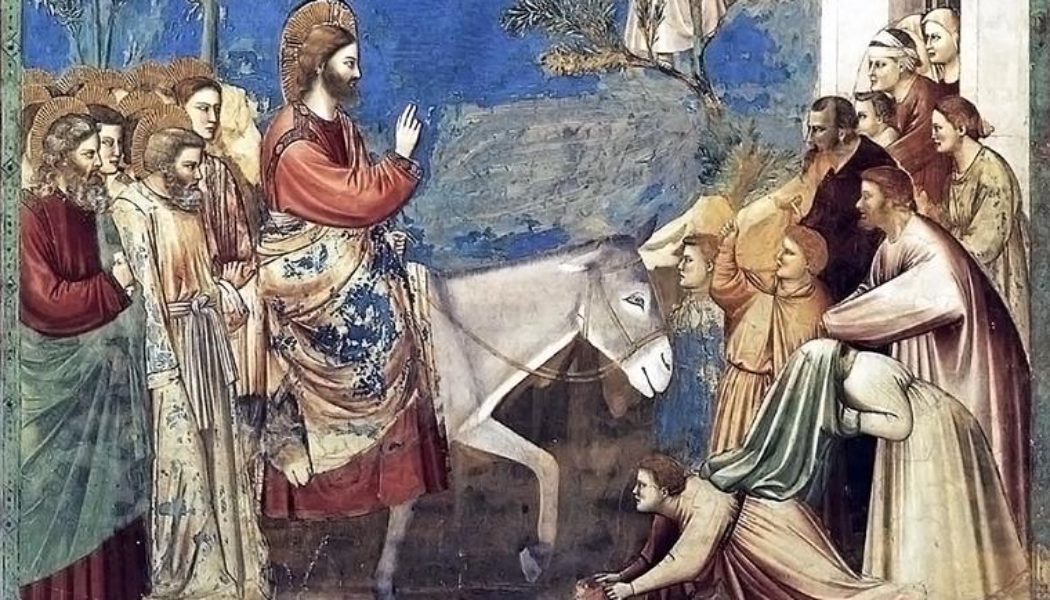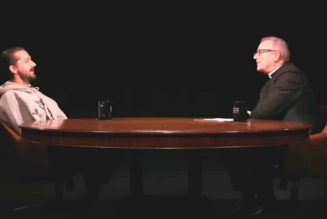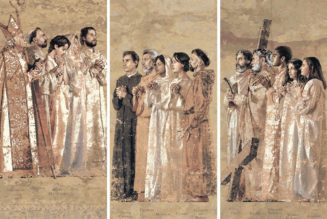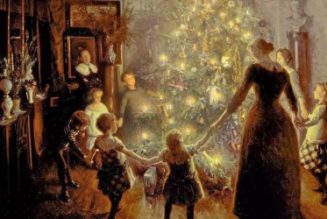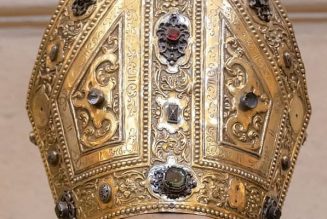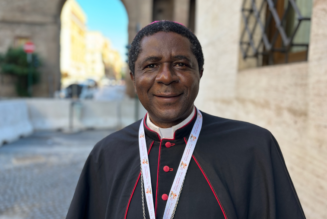
Holy Week is tremendously important in the Christian year. What is it? Where did it come from? And what happens in it?
Here are 9 things to know and share.
1) What is Holy Week?
Holy Week is the week preceding Easter Sunday. According to the General Norms for the Liturgical Year and the Calendar, “The Sixth Sunday [of Lent], on which Holy Week begins, is called, ‘Palm Sunday of the Passion of the Lord’” (No. 30).
Holy Week thus begins on the Sixth Sunday of Lent, and the period is characterized by a variety of liturgical celebrations. These have changed over time, but the Oxford Dictionary of the Christian Church states:
The various traditional rites of the week, of which each day has its own, probably began to develop at Jerusalem in the 4th cent., when pilgrimages became easily possible, and Christians could indulge a natural desire to re-enact the last scenes of the life of Christ in liturgical drama.
The Pilgrimage of Egeria, now generally thought to describe a visit in 381-4, gives a detailed account of the contemporary observance of Holy Week in Jerusalem.
Because of Holy Week’s importance, the liturgical celebrations during it take precedence over any other celebrations that would otherwise occur in the period (e.g., saints’ days). The General Norms state, “the weekdays of Holy Week, from Monday up to and including Thursday, take precedence over all other celebrations” (No. 16a).
2) What happens on the Sunday of Holy Week?
On this day, the liturgy commemorates both Jesus’ Triumphal Entry into Jerusalem and his Passion.
The Triumphal Entry was an event in which Jesus conspicuously fulfilled the messianic prophecy of Zechariah 9:9 — “Rejoice greatly, O daughter of Zion! Shout aloud, O daughter of Jerusalem! Behold, your king comes to you; triumphant and victorious is he, humble and riding on a donkey, on a colt the foal of a donkey.” He thus openly displayed himself as the messianic king of the Jews.
During this event, the crowds waved palm branches to hail his arrival, which is why the day is called Palm Sunday and why we use palm fronds in the liturgy on this day.
We know the event happened on this day because John reports that Jesus was anointed at Bethany “six days before the Passover” (John 12:1) — that is before, Good Friday — and that he made his final entry to Jerusalem “the next day” (12:12). Therefore, the entry occurred on the Sunday preceding Passover.
On this day the liturgy also commemorates the Passion of Jesus, and the Gospel reading is devoted to his suffering and crucifixion with which the week climaxes.
3) What happens on the Monday of Holy Week?
In the Gospels, Mark 11:12 reports that “on the following day” (Holy Monday), Jesus was returning to Jerusalem from an overnight stay in Bethany when he found a fig tree displaying leaves but no fruit and cursed it.
He then went to Jerusalem where he found the Temple polluted by people buying and selling, and he cleared them out.
Jesus also begins teaching in the Temple daily.
In the liturgy, the Gospel reading for this day is from John, and it backs up in time to the day before the Triumphal Entry and relates the story of Jesus being anointed at Bethany. He notes that this is in preparation for his burial (12:7).
Although these events took place the previous Saturday, they are presented here in the liturgy to form a thematic narrative leading up to the Crucifixion.
4) What happens on the Tuesday of Holy Week?
In the Gospels, Mark reports that on this day “they passed by in the morning” (Mark 11:20), they saw the fig tree that Jesus had cursed withered.
Jesus continued to teach in the Temple on this day.
In the liturgy, the Gospel reading is from John 13, and it records Jesus’ prediction at the Last Supper that one of the Twelve — Judas — will betray him. Judas then leaves the meal, and Jesus predicts that Peter will deny him three times.
These events took place on Holy Thursday, but they are presented here to continue the thematic narrative leading up to Jesus’ crucifixion.
5) What happens on the Wednesday of Holy Week?
In the Gospels, Mark 14:1 reports that “it was two days before the Passover” (i.e., Holy Wednesday), and the chief priests and scribes were plotting how to kill Jesus.
Judas Iscariot then went to the chief priests and offered to betray him (Mark 14:10). Judas thus agreed to spy on Jesus, and so Holy Wednesday is sometimes called “Spy Wednesday.”
In the liturgy, the Gospel reading is from Matthew 26, and it covers how Judas agreed to betray Jesus, along with events that occurred the next day, including the beginning of the Last Supper.
6) What happens on the Thursday of Holy Week?
In the Gospels, Jesus and his disciples sacrificed the Passover lamb (Mark 14:12) and found the location where Jesus had arranged — ahead of time — to eat the Last Supper. This involved a subterfuge. Instead of just telling the disciples where they would eat the Passover, Jesus sent two of them into the city, where they would find a man carrying a jar of water (an unusual sign, as this was normally women’s work). They were to follow this man home, enter the house, and the homeowner would then show them an already furnished guest room.
The apparent purpose of this subterfuge was to keep Judas from knowing in advance where the meal would be eaten, preventing him from being able to betray Jesus before the Last Supper.
At the event, Jesus washed the disciples’ feet (John 13:1-20) and predicted his betrayal by Judas and his denial by Peter. Most notably, in the words of Pope St. John Paul II, it was at the Last Supper “when the Lord Jesus gave to the Church the gift of the Eucharist, and with it instituted our priesthood.”
During this supper, Jesus also said, “A new commandment I give to you: that you love one another — just as I have loved you, that you also love one another” (John 13:34). The Latin word for “commandment” is mandatum, and this passed over into English as “maundy.” Consequently, this day is sometimes called Maundy Thursday — the day Jesus gave this commandment.
Afterward, they went to the garden of Gethsemane, where Jesus prayed before Judas arrived with an arresting party. He was taken to the home of the high priest, where Peter denied him three times, and a hearing was conducted before Caiaphas. Some of this likely occurred after midnight, meaning it technically happened early on Good Friday.
In the liturgy, on the morning of Holy Thursday, it is customary for the bishop and the priests of his diocese to celebrate a “Chrism Mass,” in which the oils used in the sacraments are consecrated. (However, for logistical reasons this Mass can be celebrated on another day.)
In the evening, the season of Lent ends with the beginning of the Mass of the Lord’s Supper. According to the General Norms, Lent runs “from Ash Wednesday up to but excluding the Mass of the Lord’s Supper” (No. 28).
A new liturgical season — the Paschal Triduum — begins at this point. “The Paschal Triduum of the Passion and Resurrection of the Lord begins with the evening Mass of the Lord’s Supper” (No. 19).
The Gospel reading at this Mass is from John 13, where Jesus washes the disciples’ feet, and — optionally — the priest celebrating the Mass may do the same for some of the faithful.
Afterward, the altar is stripped, the Eucharist is processed to a place of repose, and a period of silent Eucharistic adoration is held.
7) What happens on the Friday of Holy Week?
In the Gospels, Jesus was brought before the Roman governor, Pontius Pilate, early in the morning. Apparently, proceedings involving the high priest had lasted all night, as John tells us that the Jewish officials had not yet been able to eat the Passover meal (18:28).
At this point, Matthew tells us that Judas repented and insisted on returning the money he had been paid to betray Jesus, after which he hanged himself (Matthew 27:3-10).
A series of legal proceedings followed, including a hearing before Herod Antipas (Luke 23:6-12). However, ultimately Jesus was condemned to be crucified.
During the Crucifixion, “from the sixth hour there was darkness over all the land until the ninth hour” (Matthew 27:45) — that is, from about noon to about 3 p.m. — at which point Jesus died.
Since the sabbath was about to begin at sundown, a hasty burial was arranged for Jesus in the tomb of Joseph of Arimathea — a Christian who was a member of the Jewish council — since this tomb was located near where Jesus was crucified (John 19:38-42).
In the liturgy, the season of Triduum continues. Mass is not celebrated on this day. Instead, a Communion service is held (often at about 3 p.m.). This consists of a liturgy of the word, the veneration of the cross, and the distribution of holy Communion.
8) What happens on the Saturday of Holy Week?
In the Gospels, the only report we have of this day is from Luke 23:56: “On the sabbath they [the disciples] rested according to the commandment.”
In the liturgy, the season of Triduum continues. During the daytime hours, Mass is not celebrated, and holy Communion is given only to the dying.
However, after nightfall, a vigil Mass commemorating the Resurrection of Jesus on Easter is celebrated (i.e., Easter Vigil).
This Mass includes a special ceremony in which the faithful hold lighted lamps or candles, reflecting the parable of the wise and foolish virgins (Matthew 25:1-13), where the wise virgins await Christ’s return with lighted lamps.
It is also customary for catechumens to be baptized and, in many places, for already baptized candidates to be received into the Church. They are also confirmed and receive their first holy Communion, completing the sacraments of Christian initiation.
At this point, Holy Week itself is over, but there is more to the story …
9) What happens on Easter Sunday?
In the Gospels, the disciples first learned of the Resurrection after the women went to the tomb and met angels, who revealed that it was empty. This triggered a period of confusion among the disciples, but the confusion was dispelled when Jesus himself appeared to them, initiating the season of Easter joy.
In the liturgy, a single Mass is celebrated in the morning. The Gospel reading is from John 20:1-9, which records the discovery of the empty tomb by Mary Magdalen and how Peter and the beloved disciple ran to the site and found her report was true.
The season of Triduum then concludes. The General Norms state that it “closes with Vespers (Evening Prayer) of the Sunday of the Resurrection” (No. 19).
At that point, the joyous liturgical season of Easter begins.
